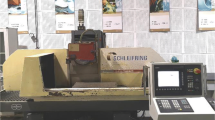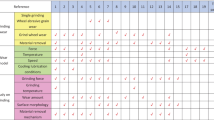Abstract
In this article, the finite element model containing the varied coefficients of friction is established in order to improve the prediction accuracy of surface grinding temperature of particulate reinforced titanium matrix composites (PTMCs). The coefficients of friction, such as 0.46 for conventional-speed grinding and 0.21 for high-speed grinding, respectively, are determined according to the grinding forces ratios measured. Results obtained show that the relative error of experimental and predicted grinding forces is limited within 2∼9 %, while the relative error of experimental and predicted grinding temperatures values is controlled at 7∼15 %. The prediction accuracy is improved significantly based on the varied coefficients of friction in surface grinding of PTMCs.
Similar content being viewed by others
References
Klocke F, Soo SL, Karpuschewski B, Webster JA, Novovic D, Elfizy A, Tonissen S (2015) Abrasive machining of advanced aerospace alloys and composites. CIRP Annals-Manuf Technol 64(2):581–604
Choi BJ, Kim IY, Lee YZ, Kim YJ (2014) Microstructure and friction/wear behavior of (TiB + TiC) particulate-reinforced titanium matrix composites. Wear 318:68–77
Blau PJ, Jolly BC (2009) Relationships between abrasive wear, hardness, and grinding characteristics of titani-um-based metal-matrix composites. J Mater Eng Perform 18(4):424–432
Zhao B, Ding WF, Dai JB, Xi XX, Xu JH (2014) A comparison between conventional speed grinding and super-high speed grinding of (TiCp + TiBw)/Ti-6Al-4V composites using vitrified CBN wheel. Int J Adv Manuf Technol 72:69–75
Li Z, Ding WF, Shen L, Xi XX, Fu YC (2016) Comparative investigation on high-speed grinding of TiCp/Ti-6Al-4V particulate reinforced titanium matrix composites with single-layer electroplated and brazed CBN wheels. Chin J Aeronaut. doi:10.1016/j.cja.2016.01.005
Rowe WB, Bell WF, Brough D, Davies BJ (1986) Optimization studies in high removal rate centreless grinding. CIRP Annals-Manuf Technol 35(1):235–238
Tian L, Fu YC, Xu JH, Li HY, Ding WF (2015) The influence of speed on material removal mechanism in high speed grinding with single grit. Int J Mach Tools Manuf 89:192–201
Jin T, Cai GQ (1999) Strain rate strengthening of workpiece material and the size effect involved in grinding. China Mech Eng 10(12):1401–1403
Feng BF (2001) Research on ultra-high speed grinding experiments with single-grit. Northeastern University, Shenyang
Moufki A, Molinari A, Dudzinski D (1998) Modelling of orthogonal cutting with a temperature dependent friction law. J Mech Physics Solids 46(10):2103–2138
Chowdhury MA, Helali M (2008) The effect of amplitude of vibration on the coefficient of friction for different materials. Tribol Int 41(4):307–314
Chowdhury MA, Khalil MK, Nuruzzaman DM, Rahamanet ML (2011) The effect of sliding speed and normal load on friction and wear property of aluminum. Int J Mech Mechatronics Eng 11(1):45–49
Ding WF, Xu JH, Shen M, Fu YC, Xiao B, Su HH, Xu HJ (2007) Development and performance of monolayer brazed CBN grinding tools. Int J Adv Manuf Technol 34:491–495
Sun Y, Sun J, Li J, Xiong Q (2014) An experimental investigation of the influence of cutting parameters on cutting temperature in milling Ti6Al4V by applying semi-artificial thermocouple. Int J Adv Manuf Technol 70:765–773
Jin T, Stephenson DJ (2004) Three dimensional finite element simulation of transient heat transfer in high efficiency deep grinding. CIRP Annals-Manuf Technol 53(1):259–262
Li Z, Ding WF, Ma CY, Xu JH (2015) Grinding temperature and wheel wear of porous metal-bonded cubic boron nitride superabrasive wheels in high-efficiency deep grinding. Proc Inst Mech Eng B J Eng Manuf:0954405415617928
Johnson GR, Cook WH (1983) A constitutive model and data for metals subjected to large strains, high strain rates and high temperatures. Proceedings of the 7th International Symposium on Ballistics 21:541–547
Ge YF, Huang HX, Xu JH (2016) Dynamic compressive behavior and failure mechanism of in-situ synthesized titanium matrix composites at high temperature and high strain rate. Acta Materiae Compositae Sinica. doi:10.13801/j.cnki.fhclxb.20160118.003
Zhang YB, Li CH, Zhang Q, Jia DZ, Wang S, Zhang DK, Mao C (2016) Improvement of useful flow rate of grinding fluid with simulation schemes. Int J Adv Manuf Technol 84:2113–2126
Yu TY, Bastawros AF, Chandra A (2015) Modeling wear process of electroplated CBN grinding wheel. In: Proceedings of the ASME. International manufacturing science and engineering conference. Charlotte, North Carolina, USA, pp 1–7
Zhang ZY, Huo YX, Guo DMA (2013) Model for nanogrinding based on direct evidence of ground chips of silicon wafers. Sci China-Technol Sci 56(9):2099–2108
Yu TY, Bastawros AF, Chandra A (2014) Experimental characterization of electroplated CBN grinding wheel wear: topology evolution and interfacial toughness. In: Proceedings of the ASME. International Manufacturing Science and Engineering Conference. Detroit, Michigan, USA, pp 1–8
Xu WX, Zhang LC (2014) On the mechanics and material removal mechanisms of vibration-assisted cutting of unidirectional fibre-reinforced polymer composites. Int J Mach Tools Manuf 80-81:1–10
Wang YG, Li CH, Zhang YB, Yang M, Li BK, Jia DZ, Hou YL, Mao C (2016) Experimental evaluation of the lubrication properties of the wheel/workpiece interface in minimum quantity lubrication (MQL) grinding using different types of vegetable oils. J Clean Prod 127:487–499
Zhang ZY, Huo FW, Wu YQ, Huang H (2011) Grinding of silicon wafers using an ultrafine diamond wheel of a hybrid bond material. Int J Mach Tools Manuf 51(1):18–24
Yu TY, Asplund DT, Bastawros AF, Chandra A (2016) Performance and modeling of paired polishing process. Int J Mach Tools Manuf 109:49–57
Luttervelt CAV, Childs THC, Jawahir IS, Klocke F, Venuvinod PK et al (1998) Present situation and future trends inmodeling of machining operations progress report of the CIRP working group ‘modeling of machining operations’. CIRP Annals-Manuf Technol 47(2):587–626
Xu XP, Huang H, Yu YQ, Li Y (1999) Friction effect between diamond and granite in circular sawing. Tribology 19(4):304–310
Yang XP, Liu CR (2002) A new stress-based model of friction behavior in machining and its significant impact on residual stresses computed by finite element method. Int J Mech Sci 44(4):703–723
Chen JY, Xu XP (2014) Tribological characteristics in high-speed grinding of alumina with brazed diamond wheels. Int J Adv Manuf Technol 71:1579–1585
Xu XP (1999) Friction studies on the process in circular sawing of granites. Tribol Lett 7(4):221–227
Xu XP, Li Y, Malkin S (2001) Forces and energy in circular sawing and grinding of granite. ASME J Manuf Sci Eng 123(1):305–312
Chen ZZ, Xu JH, Ding WF, Ma CY, Fu YC (2015) Grinding temperature during high-efficiency grinding Inconel 718 using porous CBN wheel with multilayer defined grain distribution. Int J Adv Manuf Technol 77:165–172
Liu CJ, Ding WF, Li Z, Yang CY (2016) Prediction of high-speed grinding temperature of titanium matrix composites using BP neural network based on PSO algorithm. Int J Adv Manuf Technol. doi:10.1007/s00170-016-9267-z
Author information
Authors and Affiliations
Corresponding author
Rights and permissions
About this article
Cite this article
Li, Z., Ding, W., Liu, C. et al. Prediction of grinding temperature of PTMCs based on the varied coefficients of friction in conventional-speed and high-speed surface grinding. Int J Adv Manuf Technol 90, 2335–2344 (2017). https://doi.org/10.1007/s00170-016-9578-0
Received:
Accepted:
Published:
Issue Date:
DOI: https://doi.org/10.1007/s00170-016-9578-0




